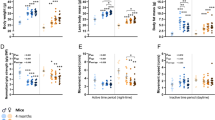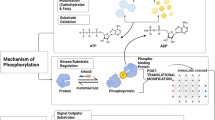Abstract
Dystrophin deficiency leads to the progressive muscle wasting disease Duchenne muscular dystrophy (DMD). Dystrophin-deficient mdx mice are characterized by skeletal muscle weakness and degeneration but they appear outwardly normal in contrast to DMD patients. Mice lacking both dystrophin and the dystrophin homolog utrophin [double knockout (dko)] have muscle degeneration similar to mdx mice, but they display clinical features similar to DMD patients. Dko limb muscles also lack postsynaptic membrane folding and display fiber-type abnormalities including an abundance of phenotypically oxidative muscle fibers. Extraocular muscles, which are spared in mdx mice, show a significant pathology in dko mice. In this study, microarray analysis was used to characterize gene expression differences between mdx and dko tibialis anterior and extraocular skeletal muscles in an effort to understand the phenotypic differences between these two dystrophic mouse models. Analysis of gene expression differences showed that upregulation of slow muscle genes specifically characterizes dko limb muscle and suggests that upregulation of these genes may directly account for the more severe phenotype of dko mice. To investigate whether any upregulation of slow genes is retained in vitro, independent of postsynaptic membrane abnormalities, we derived mdx and dko primary myogenic cultures and analyzed the expression of Myh7 and Myl2. Real-time reverse transcriptase-polymerase chain reaction analysis demonstrates that transcription of these slow genes is also upregulated in dko vs mdx myotubes. This data suggests that at least part of the fiber-type abnormality is due directly to the combined absence of utrophin and dystrophin and is not an indirect effect of the postsynaptic membrane abnormalities.



Similar content being viewed by others
References
Campbell KP (1995) Three muscular dystrophies: loss of cytoskeleton-extracellular matrix linkage. Cell 80:675–679
Ahn AH, Kunkel LM (1993) The structural and functional diversity of dystrophin. Nat Genet 3:283–291
Tinsley JM, Blake DJ, Zuellig RA, Davies KE (1994) Increasing complexity of the dystrophin-associated protein complex. Proc Natl Acad Sci U S A 91:8307–8313
Hemmings L, Kuhlman PA, Critchley DR (1992) Analysis of the actin-binding domain of alpha-actinin by mutagenesis and demonstration that dystrophin contains a functionally homologous domain. J Cell Biol 116:1369–1380
Rybakova IN, Amann KJ, Ervasti JM (1996) A new model for the interaction of dystrophin with F-actin. J Cell Biol 135:661–672
Way M, Pope B, Cross RA, Kendrick-Jones J, Weeds AG (1992) Expression of the N-terminal domain of dystrophin in E. coli and demonstration of binding to F-actin. FEBS Lett 301:243–245
Suzuki A, Yoshida M, Hayashi K, Mizuno Y, Hagiwara Y, Ozawa E (1994) Molecular organization at the glycoprotein-complex-binding site of dystrophin. Three dystrophin-associated proteins bind directly to the carboxy-terminal portion of dystrophin. Eur J Biochem 220:283–292
Jung D, Yang B, Meyer J, Chamberlain JS, Campbell KP (1995) Identification and characterization of the dystrophin anchoring site on beta-dystroglycan. J Biol Chem 270:27305–27310
Rosa G, Ceccarini M, Cavaldesi M, Zini M, Petrucci TC (1996) Localization of the dystrophin binding site at the carboxyl terminus of beta-dystroglycan. Biochem Biophys Res Commun 223:272–277
Koenig M, Monaco AP, Kunkel LM (1988) The complete sequence of dystrophin predicts a rod-shaped cytoskeletal protein. Cell 53:219–226
Monaco AP, Neve RL, Colletti Feener C, Bertelson CJ, Kurnit DM, Kunkel LM (1986) Isolation of candidate cDNAs for portions of the Duchenne muscular dystrophy gene. Nature 323:646–650
Emery AEH (1993) Duchenne muscular dystrophy, 2nd edn. Oxford Univ. Press, Oxford
Bradley WG, Hudgson P, Larson PF, Papapetropoulos TA, Jenkison M (1972) Structural changes in the early stages of Duchenne muscular dystrophy congenital muscular dystrophy. J Neurol Neurosurg Psychiatry 35:451–455
Conen PE, Bell CD (1970) Histopathological changes in Duchenne muscular dystrophy. J Neurol Sci 10:163–171
Matsumura K, Ervasti JM, Ohlendieck K, Kahl SD, Campbell KP (1992) Association of dystrophin-related protein with dystrophin-associated proteins in mdx mouse muscle. Nature 360:588–591
Matsumura K, Tome FM, Collin H, Leturcq F, Jeanpierre M, Kaplan JC, Fardeau M, Campbell KP (1994) Expression of dystrophin-associated proteins in dystrophin-positive muscle fibers (revertants) in Duchenne muscular dystrophy. Neuromuscul Disord 4:115–120
Ervasti JM, Ohlendieck K, Kahl SD, Gaver MG, Campbell KP (1990) Deficiency of a glycoprotein component of the dystrophin complex in dystrophic muscle. Nature 345:315–319
Sicinski P, Geng Y, Ryder-Cook AS, Barnard EA, Darlison MG, Barnard PJ (1989) The molecular basis of muscular dystrophy in the mdx mouse: a point mutation. Science 244:1578–1580
Mattson MP (2001) Pathogenesis of neurodegenerative disorders. In: Contemporary neuroscience. Humana, Totowa, NJ, pp x and 294
Tinsley J, Deconinck N, Fisher R, Kahn D, Phelps S, Gillis JM, Davies K (1998) Expression of full-length utrophin prevents muscular dystrophy in mdx mice. Nat Med 4:1441–1444
Bewick GS, Nicholson LV, Young C, O’Donnell E, Slater CR (1992) Different distributions of dystrophin and related proteins at nerve-muscle junctions. Neuroreport 3:857–860
Law DJ, Allen DL, Tidball JG (1994) Talin, vinculin and DRP (utrophin) concentrations are increased at mdx myotendinous junctions following onset of necrosis. J Cell Sci 107:1477–1483
Deconinck AE, Potter AC, Tinsley JM, Wood SJ, Vater R, Young C, Metzinger L, Vincent A, Slater CR, Davies KE (1997) Postsynaptic abnormalities at the neuromuscular junctions of utrophin-deficient mice. J Cell Biol 136:883–894
Lyons PR, Slater CR (1991) Structure and function of the neuromuscular junction in young adult mdx mice. J Neurocytol 20:969–981
Nagel A, Lehmann-Horn F, Engel AG (1990) Neuromuscular transmission in the mdx mouse. Muscle Nerve 13:742–749
Deconinck AE, Rafael JA, Skinner JA, Brown SC, Potter AC, Metzinger L, Watt DJ, Dickson JG, Tinsley JM, Davies KE (1997) Utrophin-dystrophin-deficient mice as a model for Duchenne muscular dystrophy. Cell 90:717–727
Rafael JA, Townsend ER, Squire SE, Potter AC, Chamberlain JS, Davies KE (2000) Dystrophin and utrophin influence fiber-type composition and post-synaptic membrane structure. Hum Mol Genet 9:1357–1367
Deconinck N, Rafael JA, Beckers-Bleukx G, Kahn D, Deconinck AE, Davies KE, Gillis JM (1998) Consequences of the combined deficiency in dystrophin and utrophin on the mechanical properties and myosin composition of some limb and respiratory muscles of the mouse. Neuromuscul Disord 8:362–370
Rafael JA, Cox GA, Corrado K, Jung D, Campbell KP, Chamberlain JS (1996) Forced expression of dystrophin deletion constructs reveals structure–function correlations. J Cell Biol 134:93–102
Spencer RF, Porter JD (2005) Biological organization of the extraocular muscles. Prog Brain Res 151:43–80
Porter JD, Rafael JA, Ragusa RJ, Brueckner JK, Trickett JI, Davies KE (1998) The sparing of extraocular muscle in dystrophinopathy is lost in mice lacking utrophin and dystrophin. J Cell Sci 111:1801–1811
Porter JD, Khanna S, Kaminski HJ, Rao JS, Merriam AP, Richmonds CR, Leahy P, Li J, Guo W, Andrade FH (2002) A chronic inflammatory response dominates the skeletal muscle molecular signature in dystrophin-deficient mdx mice. Hum Mol Genet 11:263–272
Friedman DJ, Nigro JM, Jakovcic S, Rabinowitz M, Umeda PK (1984) J Biol Chem 259:6674–6680
Lyons GE, Schiaffino S, Sassoon D, Barton P, Buckingham M (1990) Developmental regulation of myosin gene expression in mouse cardiac muscle. J Cell Biol 111:2427–2436
Deconinck N, Tinsley J, De Backer F, Fisher R, Kahn D, Phelps S, Davies K, Gillis JM (1997) Expression of truncated utrophin leads to major functional improvements in dystrophin-deficient muscles of mice. Nat Med 3:1216–1221
Matsushita T, Oyamada M, Fujimoto K, Yasuda Y, Masuda S, Wada Y, Oka T, Takamatsu T (1999) Remodeling of cell–cell and cell–extracellular matrix interactions at the border zone of rat myocardial infarcts. Circ Res 85:1046–1055
Porter JD, Merriam AP, Leahy P, Gong B, Feuerman J, Cheng G, Khanna S (2004) Temporal gene expression profiling of dystrophin-deficient (mdx) mouse diaphragm identifies conserved and muscle group-specific mechanisms in the pathogenesis of muscular dystrophy. Hum Mol Genet 13:257–269
Porter JD, Merriam AP, Leahy P, Gong B, Khanna S (2003) Dissection of temporal gene expression signatures of affected and spared muscle groups in dystrophin-deficient (mdx) mice. Hum Mol Genet 12:1813–1821
Sanford JL, Mays TA, Rafael-Fortney JA (2004) CASK and Dlg form a PDZ protein complex at the mammalian neuromuscular junction. Muscle Nerve 30:164–171
Irizarry RA, Bolstad BM, Collin F, Cope LM, Hobbs B, Speed TP (2003) Summaries of Affymetrix GeneChip probe level data. Nucleic Acids Res 31:e15
Pette D, Staron R (2001) Transitions of muscle fiber phenotypic profiles. Histochem Cell Biol 115:359–372
LaFramboise WA, Guthrie RD, Scalise D, Elborne V, Bombach KL, Armanious CS, Magovern JA (2003) Effect of muscle origin and phenotype on satellite cell muscle-specific gene expression. J Mol Cell Cardiol 35:1307–1318
Lee KJ, Helfman DM, Schroer TA (1992) Myosin light chain-2 luciferase transgenic mice reveal distinct regulatory programs for cardiac and skeletal muscle-specific expression of a single contractile protein gene. Nature 359:244–246
Grady RM, Teng H, Nichol MC, Cunningham JC, Wilkinson RS, Sanes JR (1997) Skeletal and cardiac myopathies in mice lacking utrophin and dystrophin: a model for Duchenne muscular dystrophy. Cell 90:729–738
Janney MJ, Allen RE, Cornelison DD (1994) Single-cell analysis of regulatory gene expression in quiescent and activated mouse skeletal muscle satellite cells. J Cell Physiol 159:379–385
Holt J, Easton J, Smith K, Goldspink DF, Smith CK, 2nd (1994) Temporal expression of myogenic regulatory genes during activation, proliferation, and differentiation of rat skeletal muscle satellite cells. J Cell Physiol 161:49–54
Garry DJ, Hawke TJ (2001) Myogenic satellite cells: physiology to molecular biology. J Appl Physiol 91:534–551
Close R (1965) Force: velocity properties of mouse muscles. Nature 206:718–719
Ng W, Grupp I, Subramaniam A, Robbins J (1991) Cardiac myosin heavy chain mRNA expression and myocardial function in the mouse heart. Circ Res 68:1742–1750
Tajsharghi H, Thornell LE, Lindberg C, Lindvall B, Henriksson KG, Oldfors A (2003) Myosin storage myopathy associated with a heterozygous missense mutation in MYH7. Ann Neurol 54:494–500
Perrot A, Schmidt-Traub H, Hoffmann B, Prager M, Bit-Avragim N, Rudenko RI, Usupbaeva DA, Kabaeva Z, Imanov B, Mirrakhimov MM et al (2005) Prevalence of cardiac beta-myosin heavy chain gene mutations in patients with hypertrophic cardiomyopathy. J Mol Med 83:468–477
Villard E, Duboscq-Bidot L, Charron P, Benaiche A, Conraads V, Sylvius N, Komajda M (2005) Mutation screening in dilated cardiomyopathy: prominent role of the beta myosin heavy chain gene. Eur Heart J 26:794–803
Acknowledgements
This work was supported by the Muscular Dystrophy Association (to JRF), NIH R01 EY12779 (to JDP), and in part, by a Career Award in the Biomedical Sciences from the Burroughs Wellcome Fund (to JRF). PEB was supported by an NIH supplement (AR47034-S). We would like to thank Jaimy Lekan, Katherine L. Gardner, Jonathan Edwards, and Chad Groer for technical assistance and the Biochemistry and Molecular Biology Core, Department of Veterinary Biosciences, OSU for the use of the real-time PCR machine.
Author information
Authors and Affiliations
Corresponding author
Rights and permissions
About this article
Cite this article
Baker, P.E., Kearney, J.A., Gong, B. et al. Analysis of gene expression differences between utrophin/dystrophin-deficient vs mdx skeletal muscles reveals a specific upregulation of slow muscle genes in limb muscles. Neurogenetics 7, 81–91 (2006). https://doi.org/10.1007/s10048-006-0031-7
Received:
Accepted:
Published:
Issue Date:
DOI: https://doi.org/10.1007/s10048-006-0031-7




